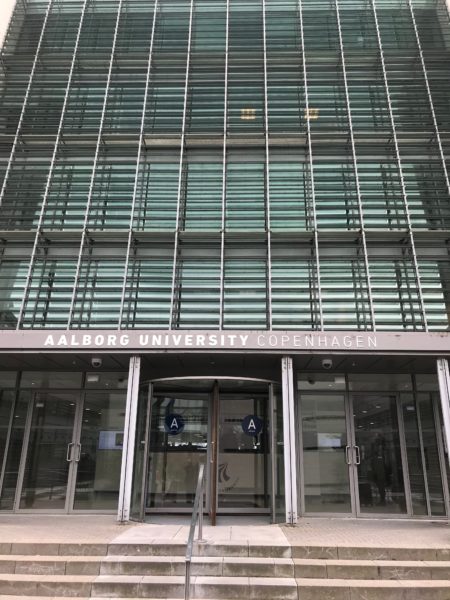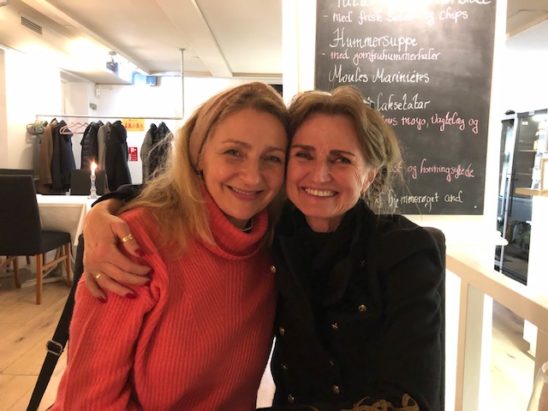
Aalborg University and digital learning
I have just completed a visit to my third Danish university (University of Copenhagen in 2004, Syddansk University in 2017, and now Aalborg University this week. I was also in Copenhagen in 2008 for a conference organised by the Danish Ministry of Science, Technology and Development).
Aalborg University (AAU) has three campuses, one – surprise, surprise – in Aalborg, one in Copenhagen, and one in Esbjerg. Aalborg University differentiates itself from the older and more traditional Danish universities through a pedagogical approach based on problem-centred, real-life projects of educational and research relevance. With the problem-based, project-organised model, semesters at AAU are centred around complex real-life problems which students attempt to find answers to in a scientific manner while working together in groups.
What I did at AAU
I visited both the Copenhagen and Aalborg campuses this week, at each giving a keynote talk on ‘PBL 2.0: Enhancing studying and students’ learning in a digital age’ and a workshop on ‘Blended learning: what models work best?’
These were part of a Teaching Day conference organised by my good friend and colleague Elsebeth Korsgaard Sorensen, Professor in Digital Communication & Learning, and by Dorina Gnaur, Associate Professor, AAU Learning Lab.

I am not an expert on problem-based learning, nor did I want to teach my grandmother how to suck eggs, so in the keynote I focused on the need for:
- institutions and instructors to help students develop a range of ‘soft’ or intellectual and social skills within their subject domain,
- such skills to be incrementally developed throughout a program, and
- all subject areas to ensure that their students have the digital knowledge and skills to succeed within their subject domain.
In the keynote I focused on what we know about how to develop skills, and the implications for the design of teaching and the use of technology to support skills development.
In the workshop I drew on my book ‘Teaching in a Digital Age‘ to help participants decide on the appropriate mix of face-to-face and online teaching, for a topic and the types of students chosen by the participants. I also got participants to use the SECTIONS model to explore the appropriate choice of technology for their topic.
What I learned at AAU
As always, I learned a lot from others.
There was a second keynote, by Jan Damsgaard, Head of The Department of Digitalization, Copenhagen Business School. He is also a member of the Danish Disruption Council established by the Danish government, with the Prime Minister in the chair, eight other cabinet ministers, CEOs of leading Danish companies, trades union leaders, and a couple of academics. Its objectives are:
- A prosperous country: Denmark must be among the most prosperous countries in the OECD.
- An open country: Denmark must remain an open country that is among the leading participants in global trade and which does business with the whole world on fair terms.
- Equal opportunities for all: Denmark must remain a safe and secure country with few divisions between people, strong social cohesion and equal opportunities for all.
Certainly, the Canadian Federal government could learn a great deal from this Danish initiative. What the Danish government is seeking to do is to ensure that Danes reap the benefits of digitalisation while at the same time managing it to the benefit of the whole Danish society. As a result the Disruption Council has already achieved the following in under one year:
- described how the Danish education system can be improved to meet the societal needs of the future, including improving digital ‘competences’ in higher education: I noticed in particular that the Government proposes to establish national awards for excellence in teaching in higher education programmes, similar to the awards that exist in the world of research;
- increased support for lifelong learners;
- more apprenticeship and vocational training;
- an agreement with Airbnb on the conditions for rental of accommodation in Denmark, and a separate agreement with Airbnb so that rental income is automatically reported to Danish tax authorities;
- establishment of a Data Ethics Council;
- a national agreement with Uber on the conditions for ride sharing services and with Hilfr on shared cleaning services;
- an agreement to allocate funds for a pilot scheme on giving socially vulnerable citizens a social tax exemption.
The government has secured multi-party support for many of these initiatives.
In Jan Damsgaard’s presentation, he identified several major ‘disruptive’ trends that will impact on society. In particular, the move to services provided by global Internet companies risks not only the loss of jobs but also the loss of many current sources of taxes for government. The Disruption Council is looking at ways to better regulate services provided by out-of-country organizations within Denmark.
The response from faculty
Following the two keynotes, there was a question and answer session using Slido to get questions from the audience for Jan Damsgaard and myself. As might be expected, some faculty were doubtful about the ability of students to discuss and collaborate online in a problem-based learning approach. Also not unexpectedly some faculty were concerned about the extra work needed to move their teaching online. I tried to reassure them on both issues by describing best online practices in these areas.
Lastly the question of technology determinism was raised: were some of these trends that have negative social effects inevitable, or do we have choice or control over these developments? Jan Damsgaard argued that the broad trends were inevitable but we can make the most of them through good policies and regulation.
I argued that the best way to ensure that individuals got more choice in the management of digital trends was to better educate our students so that they know and understand how digital technologies work, how digital companies operate, and how digitisation will impact on their lives. I said it was important to ensure that all students learn to consider the social and ethical implications, and are vigilant about the unintended consequences, of digitalisation. However, they can do this only if they are encouraged and enabled to use digital technology appropriately in their studies.
Conclusion
Higher education institutions in Denmark are facing the same challenges as higher education institutions elsewhere. The government is cutting university funding for teaching by 2% annually from 2019, because of the current economic situation in Denmark. This is already leading to senior faculty approaching the retirement age of 65 being given early termination. The funding cuts not only contradict the rhetoric of the Disruption Council, but they also make innovation in digital learning more difficult, as faculty fear that it is a cost cutting measure rather than a measure necessary for long-term economic and social development.
The conference, and particularly Jan Damsgaard’s presentation, did however reinforce my view that online learning, or more accurately learning digitally, is essential for a healthy and robust society, a theme I will continue in my keynote to the CNIE conference in Vancouver later this month.
Reference
Government of Denmark (2019) Prepared for the Future of Work Copenhagen DK: The Ministry of Employment










 Dr. Tony Bates is the author of eleven books in the field of online learning and distance education. He has provided consulting services specializing in training in the planning and management of online learning and distance education, working with over 40 organizations in 25 countries. Tony is a Research Associate with Contact North | Contact Nord, Ontario’s Distance Education & Training Network.
Dr. Tony Bates is the author of eleven books in the field of online learning and distance education. He has provided consulting services specializing in training in the planning and management of online learning and distance education, working with over 40 organizations in 25 countries. Tony is a Research Associate with Contact North | Contact Nord, Ontario’s Distance Education & Training Network.

